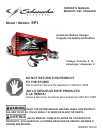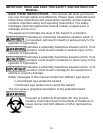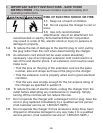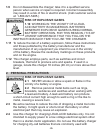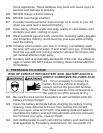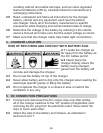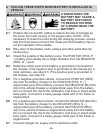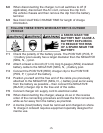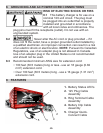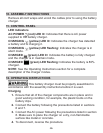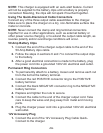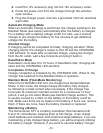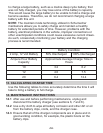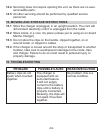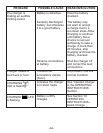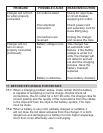
•6•
FOLLOW THESE STEPS WHEN BATTERY IS INSTALLED IN 6.
VEHICLE
A SPARK NEAR THE
BATTERY MAY CAUSE A
BATTERY EXPLOSION.
TO REDUCE THE RISK
OF A SPARK NEAR THE
BATTERY:
Position the AC and DC cables to reduce the risk of damage by 6.1
the hood, door and moving or hot engine parts. NOTE: If it is
necessary to close the hood during the charging process, ensure
that the hood does not touch the metal part of the battery clips or
cut the insulation of the cables.
Stay clear of fan blades, belts, pulleys and other parts that can 6.2
cause injury.
Check the polarity of the battery posts. The POSITIVE (POS, P, 6.3
+) battery post usually has a larger diameter then the NEGATIVE
(NEG, N, -) post.
Determine which post of the battery is grounded (connected) to 6.4
the chassis. If the negative post is grounded to the chassis (as in
most vehicles), see step 6.5. If the positive post is grounded to
the chassis, see step 6.6.
For a negative-grounded vehicle, connect the POSITIVE (RED) 6.5
clip from the battery charger to the POSITIVE (POS, P, +)
ungrounded post of the battery. Connect the NEGATIVE (BLACK)
clip to the vehicle chassis or engine block away from the battery.
Do not connect the clip to the carburetor, fuel lines or sheet-metal
body parts. Connect to a heavy gauge metal part of the frame or
engine block.
For a positive-grounded vehicle, connect the NEGATIVE (BLACK) 6.6
clip from the battery charger to the NEGATIVE (NEG, N, -)
ungrounded post of the battery. Connect the POSITIVE (RED)
clip to the vehicle chassis or engine block away from the battery.
Do not connect the clip to the carburetor, fuel lines or sheet-metal
body parts. Connect to a heavy gauge metal part of the frame or
engine block.
Connect charger AC supply cord to electrical outlet.6.7



